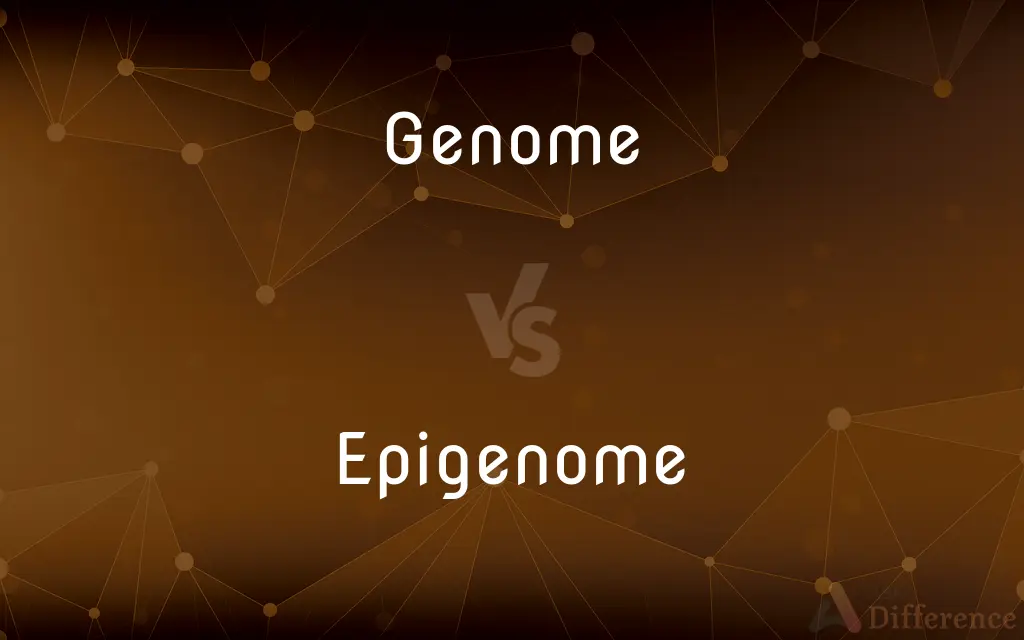Genome vs. Epigenome — What's the Difference?
Edited by Tayyaba Rehman — By Urooj Arif — Updated on April 3, 2024
A genome encompasses all genetic material of an organism, dictating its inherited features. The epigenome, however, consists of chemical compounds that modify or mark the genome, influencing gene activity without altering the DNA sequence.

Difference Between Genome and Epigenome
Table of Contents
ADVERTISEMENT
Key Differences
A genome is the complete set of DNA in an organism, including all of its genes. It serves as a blueprint for building and maintaining that organism throughout its life. Whereas the epigenome is made up of chemical changes to the DNA and histone proteins that can turn genes on or off, essentially acting as a regulatory layer over the genome without changing the underlying DNA sequence.
While the genome is fixed for an individual, barring mutations, the epigenome can change in response to external environmental factors and internal physiological changes. This means that while the genetic code remains unchanged, the expression of genes can be dynamically altered by the epigenome based on lifestyle, diet, and even exposure to stress.
The study of the genome involves understanding the structure, function, and evolution of genes and genetic information. On the other hand, epigenetics, the study of the epigenome, focuses on how gene expression is regulated and how it can be inherited across generations without changes to the DNA sequence.
Genomic sequencing can reveal a lot about potential inherited conditions and traits. Meanwhile, epigenomic studies can offer insights into how environmental factors and lifestyle choices might influence these genetic predispositions, potentially leading to diseases or altering traits.
Both the genome and the epigenome are crucial for the development and functioning of an organism. However, while the genome provides the static code, the epigenome offers a dynamic and reversible mechanism to adapt gene expression in response to environmental stimuli.
ADVERTISEMENT
Comparison Chart
Definition
The complete set of DNA in an organism, including all its genes.
Chemical modifications and markers on the DNA and histones that regulate gene activity without altering the DNA sequence.
Changeability
Fixed, barring mutations.
Dynamic, changes in response to environmental factors and physiological conditions.
Role
Provides the genetic blueprint for an organism.
Modifies or marks the genome to influence gene activity, acting as a regulatory layer.
Study Focus
Structure, function, evolution of genes.
Regulation of gene expression, heritability of gene expression changes.
Influence on Traits
Determines inherited features and predispositions.
Modulates expression of genes, potentially affecting how traits are expressed or diseases manifested.
Compare with Definitions
Genome
Reflects evolutionary history and relationships.
Comparative genome studies show how different species are related.
Epigenome
Offers insights into gene-environment interactions.
Epigenetic studies help understand how diet and environment influence disease risk.
Genome
The complete set of an organism's DNA, including all of its genes.
Human genome mapping has revolutionized our understanding of hereditary diseases.
Epigenome
Consists of chemical compounds that regulate gene activity.
Methylation of DNA is a common epigenetic mark that can silence genes.
Genome
Contains both coding regions (genes) and non-coding DNA.
Non-coding regions of the genome play important roles in regulating gene expression.
Epigenome
Can be inherited but is reversible.
Some epigenetic changes are passed down but can be reversed with lifestyle changes.
Genome
Constant across all cells of an individual.
Every cell in your body carries the same genome but utilizes different parts of it.
Epigenome
Affects how genes are read by cells.
Histone modification can make DNA more or less accessible to the cellular machinery.
Genome
Can be sequenced to identify genetic variants.
Genome sequencing can reveal the risk for certain genetic disorders.
Epigenome
Can change in response to environmental factors.
Prolonged stress can alter the epigenome, affecting gene expression.
Genome
In the fields of molecular biology and genetics, a genome is all genetic material of an organism. It consists of DNA (or RNA in RNA viruses).
Epigenome
An epigenome consists of a record of the chemical changes to the DNA and histone proteins of an organism; these changes can be passed down to an organism's offspring via transgenerational stranded epigenetic inheritance. Changes to the epigenome can result in changes to the structure of chromatin and changes to the function of the genome.
Genome
The total genetic content contained in a haploid set of chromosomes in eukaryotes, in a single chromosome in bacteria or archaea, or in the DNA or RNA of viruses.
Epigenome
The set of heritable chemical changes to an organism's genome, such as DNA methylation or histone modification, that modify gene expression but do not change the DNA sequence itself.
Genome
An organism's genetic material.
Epigenome
(genetics) The total epigenetic state of a cell.
Genome
(genetics) The complete genetic information (either DNA or, in some viruses, RNA) of an organism.
Epigenome
(genetics) A chemical responsible for the activation of a particular gene.
Genome
The ordering of genes in a haploid set of chromosomes of a particular organism; the full DNA sequence of an organism;
The human genome contains approximately three billion chemical base pairs
Common Curiosities
What is a genome?
A genome is the complete set of DNA in an organism, including all of its genes, which contains the instructions for building and maintaining that organism.
Can the epigenome change?
Yes, the epigenome can change in response to environmental factors, lifestyle choices, and physiological changes, influencing gene activity.
What is an epigenome?
The epigenome consists of chemical modifications on the DNA and histone proteins that can change gene activity without altering the DNA sequence itself.
How is the genome analyzed?
Genome analysis involves sequencing the DNA to identify genetic variations and understanding their implications for health and disease.
How do the genome and epigenome differ?
The genome is the static genetic material of an organism, while the epigenome involves dynamic chemical changes that regulate how this genetic material is expressed.
How does the epigenome affect health?
By regulating gene expression, the epigenome can influence the development of diseases, the efficacy of drugs, and the overall health of an individual.
What is the importance of epigenetic studies?
Epigenetic studies are crucial for understanding how gene expression is regulated and how external factors can influence genetic predispositions.
Can lifestyle changes affect the epigenome?
Yes, lifestyle changes such as diet, exercise, and stress management can influence epigenetic markers and, consequently, gene expression.
Can epigenetic changes be inherited?
Yes, some epigenetic changes can be passed down to offspring, affecting gene expression in future generations without altering the DNA sequence.
What technologies are used to study the epigenome?
Technologies like DNA methylation analysis, histone modification profiling, and chromatin accessibility assays are used to study the epigenome.
Is the genome changeable?
The sequence of the genome is mostly fixed, with changes primarily occurring through mutations, whereas the epigenome is more dynamic.
What role does the environment play in the epigenome?
Environmental factors such as diet, stress, and exposure to toxins can lead to epigenetic changes, modifying gene expression patterns.
Can epigenetic changes be reversed?
Many epigenetic changes are reversible, offering potential strategies for therapeutic interventions in diseases.
Why is the genome considered static?
The genome is considered static because the DNA sequence remains largely unchanged throughout an individual's life, except for mutations.
How do genetic mutations relate to the epigenome?
While genetic mutations alter the DNA sequence, epigenetic changes modify gene expression without changing the sequence, offering different layers of genetic regulation.
Share Your Discovery

Previous Comparison
Funk vs. Punk
Next Comparison
Scaffolding vs. FalseworkAuthor Spotlight
Written by
Urooj ArifUrooj is a skilled content writer at Ask Difference, known for her exceptional ability to simplify complex topics into engaging and informative content. With a passion for research and a flair for clear, concise writing, she consistently delivers articles that resonate with our diverse audience.
Edited by
Tayyaba RehmanTayyaba Rehman is a distinguished writer, currently serving as a primary contributor to askdifference.com. As a researcher in semantics and etymology, Tayyaba's passion for the complexity of languages and their distinctions has found a perfect home on the platform. Tayyaba delves into the intricacies of language, distinguishing between commonly confused words and phrases, thereby providing clarity for readers worldwide.
















































